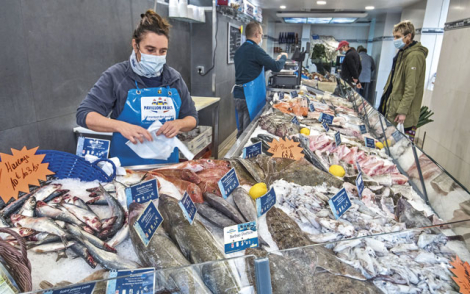|
FOCUS on
GCC countries
(Gulf Cooperation Council)
28,6 kg
Average annual per capita consumption in the United Arab
Emirates
44 %
Share of Middle East produced quantities from aquaculture
Favourite species
The main species consumed in GCC countries are orange roughy, grouper, giant oarfish, yellowfin tuna, seabream, shrimp, lobster and fish of the carangidae family.
The position of France
France is still poorly positioned on this market, but according to the latest FranceAgriMer 2019 report on 2018 figures, the main product exported to the United Arab Emirates remains oysters, with 216 tons. Next come frozen langoustine, with 12 tons,
and lobster with 9 tons. Bass and sole account for only 7 tons each.
|
|
PDM: What is the situation with seafood consumption in the Gulf countries?
François-Xavier Depireux: Seafood consumption in the Gulf Cooperation Council countries (GCC, Saudi Arabia, Oman, Kuwait, Bahrain, United Arab Emirates and Qatar) is clearly increasing over the years. According to the latest fisheries statistics published by FAO, there is a strong and growing demand and currently the average is around 20 kg per person.
However, in the United Arab Emirates, for example, seafood consumption is estimated at 28.6 kg per person. All indications are that the demand for seafood products is unlikely to reverse in the Arab Gulf States, where seafood products are consumed from the basic snack-bars to luxury hotels and restaurants. Nevertheless, we must also take into account the fact that demand exceeds supply. In terms of packaging, it can be observed that the most popular format for packed seafood in the GCC is 500 grams and 1,000 grams, sometimes 400 grams for shrimp.
How is this trend evolving?
FX.D.: Consumption is increasing every year. Five years ago, the Saudi Ministry of Agriculture invested an additional $10.6 billion in aquaculture projects to produce one million tons of fish over the next 16 years. In addition, as mentioned earlier, the demand for seafood products is steadily increasing, compared to 2010 when per capita consumption was 9 kg per year. In addition, the number of inhabitants is increasing.
What does domestic production represent compared to imports?
FX.D.: Domestic seafood production is not meeting demand. Currently, 44% of the quantities produced in the Middle East already come from aquaculture, mainly from Oman, Egypt or Iran. The wealthiest oil-producing GCC States, with the exception of Oman, are increasingly dependent on imports to meet their demand. Besides, the Gulf countries are investing heavily in pioneering fish farming initiatives, but dependency on imports will remain.
Which countries are favoured by importers and why?
FX.D.: Traders are looking for new and reliable sources of supply. Currently, the most important imports come from the nearest countries such as: Oman, Iran, Pakistan, China or Oceania. However, it is also common to import fresh products from Europe and Canada because food from these countries is perceived as being of high quality.
How are French seafood products perceived?
FX.D.: French products are generally perceived as being high quality and very tasty products. Everyone here appreciates French cuisine, which is an asset for all food products. Moreover, nowadays, it is important in the GCC to promote sustainable fishing practices which are also found in products of French origin.
What is your view on purchasing and consumption trends and what can we expect in the future?
FX.D.: Consumption is expected to increase due to international and local trends. Seafood products are popular among the general public and tourists, especially in the United Arab Emirates, where forecasts indicate that by 2030, fish consumption in the UAE alone is expected to break the 900,000-ton barrier. Demand for the region’s fresh fish products and regional and global fish suppliers is expected to grow by 8% per year until 2030.
Interview by Guillaume JORIS
Translation: Catherine ROUSSEY
|


